Welcome, orchard enthusiasts and custard apple lovers alike, to our comprehensive month-by-month guide to custard apple orchard management. Whether you’re a seasoned grower or a passionate beginner, this blog post is your go-to resource for maximizing the potential of your custard apple orchard. We’ll take you through the seasons, sharing valuable insights and practical tips for each month. Discover the secrets of nurturing these delectable fruits, unlocking their rich flavor and creamy texture.
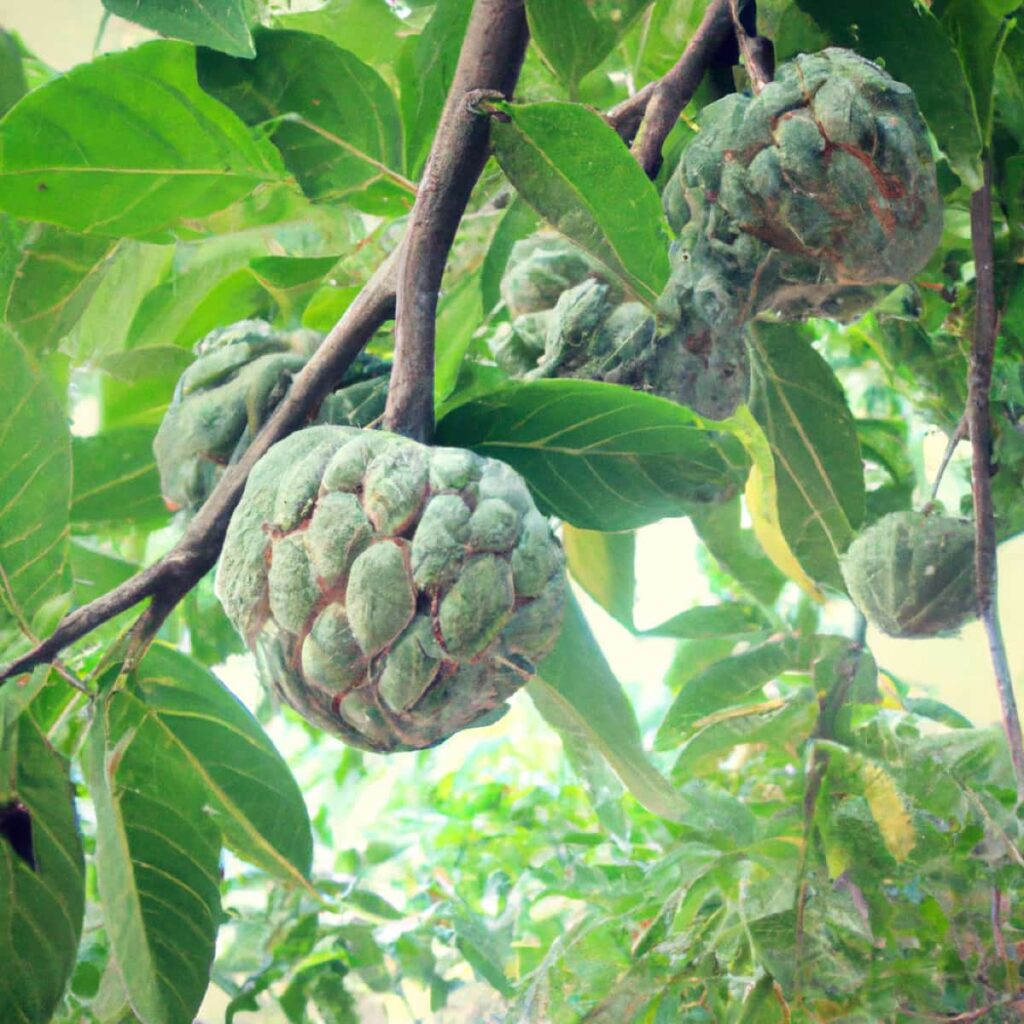
Custard Apple Orchard Management
What is Custard Apple Farming and its Overview?
Custard apple farming is cultivating custard apple trees for their fruit. Custard apple trees are native to tropical America but are now grown worldwide, including in India, China, the Philippines, Egypt, and Central Africa. Custard apple trees are hardy and can grow in various climates, but they prefer well-drained soil and full sun. The trees can grow tall and produce fruit for up to 50 years.
The fruit of the custard apple tree is a large, round, and fleshy berry. The fruit’s flesh is white, pink, or yellow and has a sweet, custard-like flavor. The fruit is the best source of vitamins A and C and potassium. Custard apple fruit can be eaten fresh or used in pies, puddings, and other desserts.
Importance of Month-Wise Planning for Custard Apple Orchard Operations
- Timely task execution: Custard Apple development requires specific actions at different phases. Planned trimming, fertilization, pest control, and irrigation maximize their effectiveness.
- Pest and disease management: Many pests and illnesses have life cycles and peak activity times. Orchard owners may prevent infestations and diseases, watch for early indicators, and act quickly to protect their crops by preparing ahead.
- Improved fruit quality: Month-wise planning allows orchard managers to thin surplus fruit, support heavy branches, and provide appropriate water and nutrients at important growth stages. Custard apples are larger, healthier, and more marketable.
- Harvest and post-harvest management: Planning prevents premature or late custard apple harvesting. It also facilitates post-harvest grading, sorting, packing, and storage, preserving fruit quality and shelf life.
- Risk mitigation: Planning helps identify risks and problems throughout the year, such as weather, disease, and market swings. Orchard owners can limit losses by planning for these dangers.
In case you missed it: Optimizing Cashew Orchard Management: A Month-by-Month Operation Guide for Maximum Yield
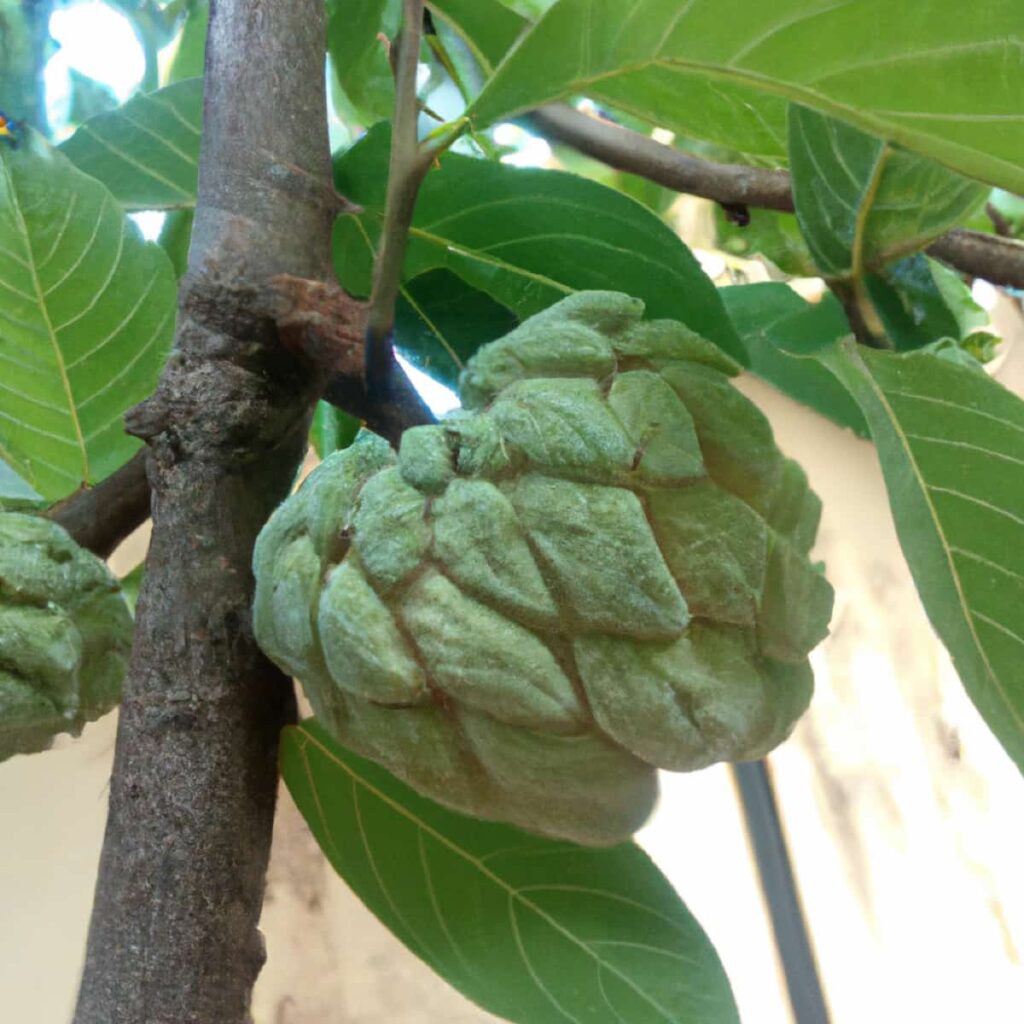
Best Tips for Practices Custard Apple Orchard Management
Climate
- Custard apples thrive in hot and dry climates with varying degrees of difference.
- A hot and dry climate is necessary during flowering, while high humidity is required for fruit sets.
- Low humidity can be harmful to pollination and fertilization.
- Custard apples can withstand drought conditions, cloudy weather, and temperatures below 15 degrees Celsius.
- Optimum annual rainfall ranges from 50-80 cm, although they can tolerate higher rainfall.
Soil
- Custard apples are adaptable to different soil conditions, including shallow and sandy soils.
- However, they require well-drained subsoil and may fail to grow in ill-drained or marshy-wet lands.
- The trees can thrive in deep black soils if they are well-drained.
- A little salinity or acidity doesn’t affect custard apples, but alkalinity, chlorine, poor drainage, or marshy-wet lands hamper growth and fruiting.
Varieties
- Some popular custard apple varieties grown in agro-climatic regions include Red Sitaphal, Balanagar, Hybrid, Washington, and Purandhar (Pune).
Propagation
- Custard apples are commonly propagated through seeds, although vegetative and budding techniques have been developed.
- Local custard apple seedlings serve as good rootstocks for improved varieties and hybrids.
- Treating seeds with 100 ppm for 24 hours helps achieve quick and uniform germination.
Planting and Season
- Plant custard apple trees during the rainy season.
- Dig pits of 60x60x60 cm, with spacing of 4×4, 5×5, or 6×6 meters, depending on soil type.
- Before the monsoon, fill the pits with good quality Farm Yard Manure (FYM), single super phosphate, and neem or Karanj cake.
- Planting with a drip irrigation system at 6×4 meters spacing has shown good growth and fruit set.
Intercultural Operations
- Regular weeding is essential to promote good plant growth and keep weeds away.
- Intercropping with legumes, peas, beans, and marigold flowers is common, but no crops are usually taken during winter as the trees rest.
Care of Young Orchard
- Fill any gaps in the orchard as early as possible.
- Ensure there is no water stagnation on impervious or poorly drained soils, especially during the first monsoon.
In case you missed it: Optimizing Sweet Orange Orchard Management: A Month-By-Month Operation Guide for Maximum Yield
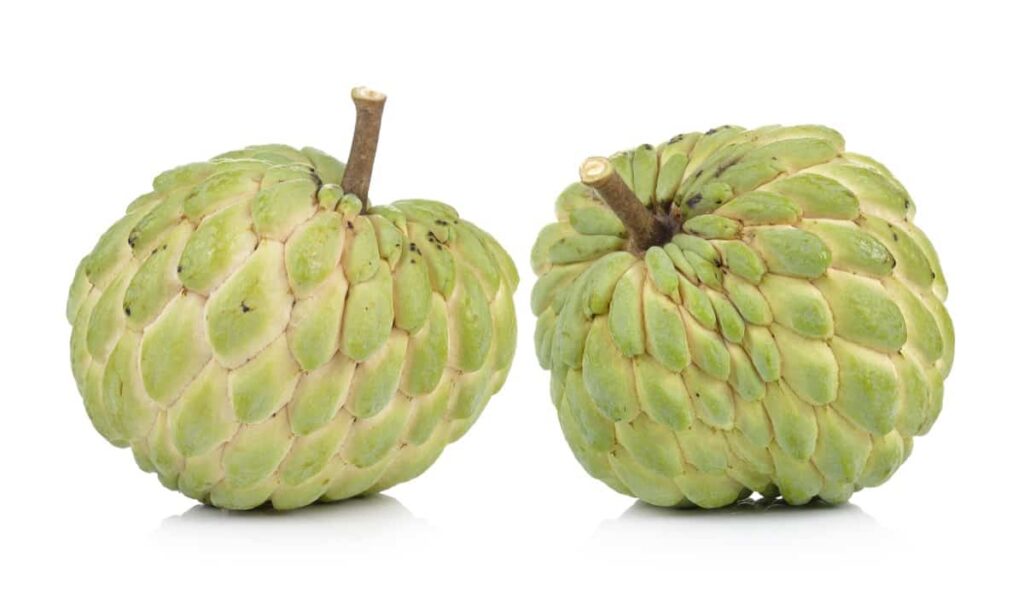
Special Horticultural Practices
- Growth regulators like Ethryl (1000 ppm) can be sprayed for defoliation and to bring plants into uniform rest.
- Biocil (1 ml per liter of water) sprayed just before flowering promotes better and early flowering.
- 10 to 20 ppm NAA sprayed before flowering helps reduce flower and fruit drop.
- Foliar spray with 50 ppm GA + 5 ppm CPPU during fruit development enhances fruit size and luster.
Irrigation
- Custard apples are generally grown as rainfed crops, but irrigation can benefit early and bumper harvests.
- Mist sprinkling over flood or drip systems is preferred to lower temperatures and increase relative humidity during flowering and fruit sets.
Nutrition
- Rainfed crops usually don’t require manures or fertilizers, but for better yields, apply recommended doses to fully grown trees.
- Micronutrient mixtures, foliar sprays, and occasional zinc or iron sprays can address deficiencies.
Plant Protection
- While custard apple crops are generally hardy, they can be susceptible to pests such as mealy bugs, scale insects, and fruit-boring caterpillars.
- To protect your orchard, consider spraying with neem oil, Meenark, and herbal preparations to control pests. Additionally, regular monitoring and early intervention can help prevent pest infestations.
Harvesting and Yield
- Custard apples are climacteric fruits harvested when they change color from green to varietal shade. Immature fruits do not ripen, so look for fruits with color changes and apical buds showing inner pulp.
- A well-grown tree can yield over 100 fruits weighing 300 to 400 grams. The harvesting season typically spans from August to October.
Post-Harvest Handling
- Custard apples are not well-suited for cold storage or extensive handling after ripening.
- Firm, mature fruits can be stored at around 6 degrees Celsius for about a week, but they may lose aroma and attractiveness while developing a slightly insipid taste.
- Handle the fruits carefully to avoid damage during post-harvest processes.
January Month Custard Apple Orchard Operations Planning
- Leaf fall may take place due to low winter temperatures.
- Ensure regular irrigations at 10 to 15 days intervals.
- Pests such as scale and mealybugs can damage the trees, while diseases such as anthracnose and powdery mildew can cause fruit rot.
February Month Custard Apple Orchard Operations Planning
- Irrigate the plants at 7 to 10 days intervals regularly.
- Check for stem and shoot borer incidence and prevent it by pulling out the borers and injecting petrol or kerosene into the damaged holes.
- Keep the weed-free basins and apply ten gms of Phorate granules/plant.
In case you missed it: Optimizing Sapodilla/Sapota Orchard Management: A Month-by-Month Operation Guide for Maximum Yield

March Month Custard Apple Orchard Operations Planning
- Apply one basket of mulch material to control evapotranspiration losses and weed growth in basins.
- By applying mulch to the basins around the custard apple trees, you can help to conserve moisture, suppress weed growth, and improve the overall health of the trees.
April Month Custard Apple Orchard Operations Planning
- Irrigate the trees regularly through drip or basin irrigation.
- Check for mealybugs and control them by spraying Acephate or Dichlorovas.
- Dig a profile pit of 3 X 3 X 3 ft to ensure soil suitability.
- Collect soil samples for every one-foot soil depth from the suitable lands profile pit dug out.
- Based on the soil test report, even if the soil PH is up to 7.5, it is considered suitable for the Custard apple plantation.
May Month Custard Apple Orchard Operations Planning
- Prepare the land by plowing twice and leveling it.
- Mark the alignment and pegs for pit digging at 6X6 more. Spacing between the rows and plants.
- Dig the pits of 60X60X60 Cm in size and place the topsoil to the right side and the bottom soil to the left side of the pit.
- Allow the pit for exposure to the sun for at least two weeks before filling the pits to control soil-born pests and diseases.
- Procure plant material from reliable nurseries, preferably from Govt. nurseries or from nurseries recommended by the Department of Horticulture.
- Select high-yielding varieties like Balanagar or Hybrid varieties like Arkasahans or FRS – Selection 1 (Atemoya X Balanagar).
- Irrigate the trees regularly through drip or at least once in 7 to 10 days intervals through basins irrigation.
- Take up summer plowing to improve soil health.
June Month Custard Apple Orchard Operations Planning
- Fill the pits with topsoil, 20 kgs of FYM, 1 kg of SSP, and 100 gm of 10% Follidol dust per pit.
- Fill the pits at least 6 inches above the ground level so that when the soil settles, it will be at the ground level at planting.
- Ensure thorn fencing or any thick growing live fence to control cattle trespassing.
- Mark out for trench cutting and complete the trench cutting for drip installation.
- With the onset of the monsoon, farmers can sow intercrops.
July Month Custard Apple Orchard Operations Planning
- Procure the grafts of recommended varieties from the selected nurseries.
- Arrange for transportation of the plant material from the nursery to the planting site.
- Keep the grafts near a water source and water them regularly until planting is done.
- If there is any delay in receiving good rains, soak the pits by giving irrigation or running the drip system. Ensure that the soil in the pit is at ground level. Otherwise, level the soil in pits.
- Plant the grafts by keeping them in the center of the pit without disturbing the ball of earth around the root system.
- Water the plant immediately after planting and provide a support stick.
- Irrigate the plants every week at ten days intervals during the first month and later at 10 to 15 days intervals if there are no rains during the initial two years.
August Month Custard Apple Orchard Operations Planning
- Weeding: Weeds should be removed at least once a month during the monsoon season to control weeds. The basins around the plant should be made to retain water.
- Mulching: Mulch the basins with paddy husk, straw, or groundnut shells to avoid evapo-transpiration losses. Mulching also helps in the control of weeds in the basins.
- Pruning: Remove the side shoots which appear from the base of the plant on the root stalk. Prune the lower branches to a height of 2 to 3 feet to obtain a perfect shape.
In case you missed it: Optimizing Coconut Orchard Operations: A Comprehensive Management Guide for Month-wise Planning
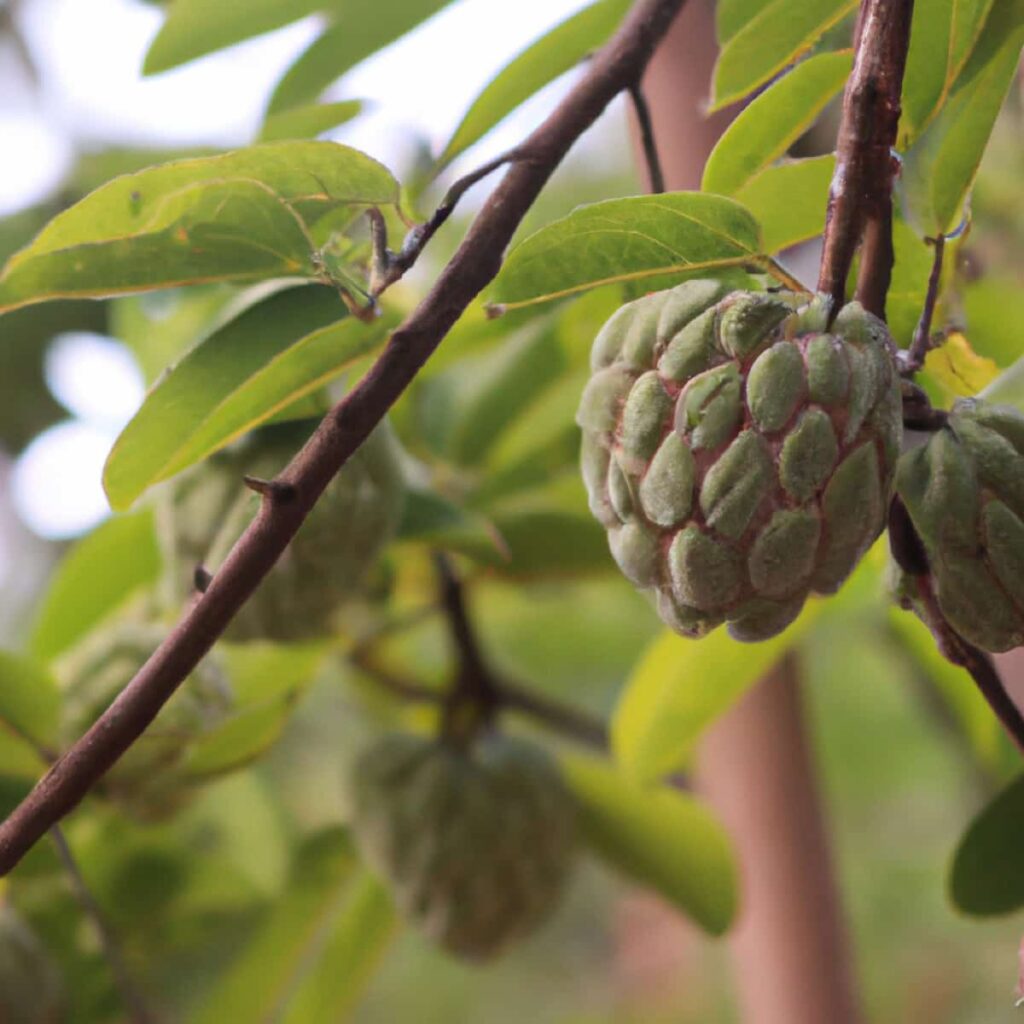
September Month Custard Apple Orchard Operations Planning
- Soil aeration: Aeration is the process of air moving through the soil. The roots of plants need to get oxygen. Soil aeration can be improved by working the soil in the basin.
- Weed control: Weeds compete with custard apple trees for water, nutrients, and sunlight. To prevent it is important to control weeds. Using a weed killer or hand weeding can both control weeds.
- Fertilize the trees regularly with a balanced fertilizer.
- Prune the trees regularly to maintain a good shape and to remove dead or disease-infected branches.
- Harvest the fruits when they are ripe.
October Month Custard Apple Orchard Operations Planning
- Gap filling: If any gaps are noticed due to the death of plants, they should be replaced by taking up gap filling.
- Pruning: Prune the side shoots that occasionally appear on the root stalk and remove side branches up to 2 to 3 feet.
- Cutting the growing shoot: Cut the growing shoot to encourage lateral branches.
- Intercropping: If inter-crop during June-July is not cultivated, farmers can sow intercrops for rabi season during this month.
November Month Custard Apple Orchard Operations Planning
- Soil working in the basins and mulching: Work the soil in the basins to keep it weed-free and to improve aeration. Mulch the basins with organic matter, such as straw or leaves, to suppress weed growth and improve the soil’s overall health.
- Pruning: Prune the side shoots that occasionally appear on the root stalk and remove side branches up to 2 to 3 feet. This will help improve the plant’s shape and encourage new growth.
- Irrigation: Ensure regular irrigations at 10 to 15 days intervals. This is especially needed during the dry season.
December Month Custard Apple Orchard Operations Planning
- Leaf fall: Leaf fall may take place due to low winter temperatures. This is a natural process, and there is no need to worry.
- Irrigation: Ensure regular irrigations at 10 to 15 days intervals. This is especially during the dry season.
In case you missed it: Optimizing Apple Orchard Operations: A Comprehensive Guide for Month-wise Planning
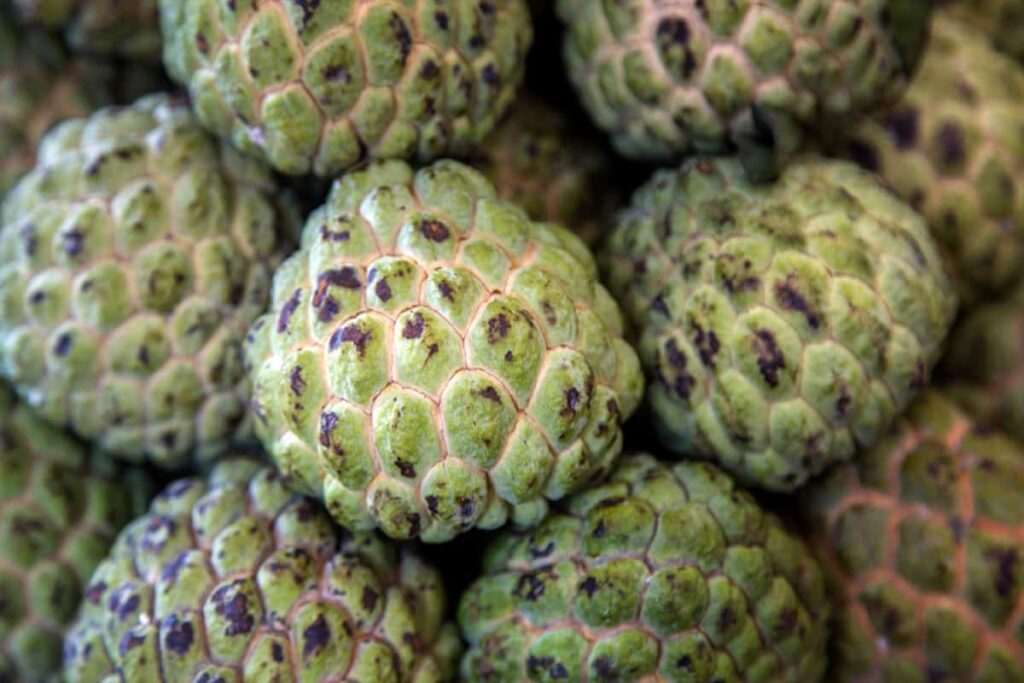
Conclusion
Following the month-by-month guide to custard apple orchard management, you can nurture thriving trees, protect against pests, optimize harvest timing, and carefully handle fruits. Embrace these practices and savor the sweet rewards of a flourishing orchard.
- Budget Friendly Sheep Shed Ideas: Cheap and Low-Cost Tips
- How Much Do Cattle Farmers Make: Revenue Streams in Cattle Farming
- Management Pests and Diseases in Your Cotton Field
- Sheep Farming Business Plan for Beginners
- Aquaponic Farming at Home: A Step-By-Step Guide
- Profitable Village Farming Business Ideas in 2024
- High-Yield Aquaculture: Fast-Growing Fish for Farming
- Effective Fish Pond Construction Techniques for Beginners
- Irrigation and Water Management in Pineapple Farming
- Blossom to Harvest: Mastering Flowering and Pollination in Papaya Farming
- Pig Fattening Essentials: From Selection to Sale for Beginners
- Raising Wagyu Cattle: A Complete Guide for Premium Beef Production
- Soil Types and Their Water Holding Capacity
- Optimizing Irrigation Schedules for Coconut Groves for Enhanced Yield
- Espresso Your Garden: Coffee Grounds for Healthier Acid-Loving Plants
- The Best Soil Mix for Snake Plants: How to Mix Your Own Snake Plant Soil
- Green Thumb Success: Expert Tips for Cultivating Greenhouse Beans All Year Round
- Bloom All Year Round: The Ultimate Guide to Indoor Hyacinth Care
- Eco-Friendly Gardening: How to Make Liquid Fertilizer from Kitchen Waste
- Ultimate Guide to Grow Anise in Pots: Explore Seed Propagation to Harvesting
- Guide to Raising Chester White Pigs: Discover Breed Facts to Growth Management
- Mastering the Elegance: The Ultimate Guide to Weeping Cherry Tree Care, Planting, and Maintenance
- Ultimate Guide to Planting Garlic in Grow Bags: Growing Strategies for Beginners
- How to Fix Spider Plant Leaf-Related Problems: Natural and Organic Remedies
- 10 Reasons Why Your Tulsi Plant is Shedding Leaves: Home Remedies and Solutions
- Optimizing Growth and Yield: The Advantages of Palm Bunch Ash Fertilizer
- Utilizing Neem Oil Extract as a Natural Pesticide for Hydrangea
- From Soil to Harvest: Various Ways in Which Farmers Can Use AI Tools
- Steps to Encourage and Induce Citrus Flowers: A Comprehensive Guide
- How to Fix Snake Plant Leaf-Related Issues: Natural and Organic Remedies
- Transform Your Garden into a Fragrant Oasis with Raat Ki Rani (Night Blooming Jasmine)
- Discover the Ideal Chicken Breeds for Philippine Farms
- How to Create a Poultry Egg Farm Business Plan for Profits
- Grow Lemon Cucumbers Like a Pro: Insider Techniques for Bountiful Yields
- Ultimate Guide to Caring for Your Pink Princess Philodendron: Tips for Thriving Variegation
- Areca Nut Profit Per Acre: Calculating Yield and Cost of Cultivation
